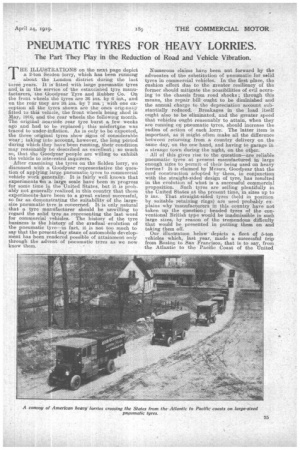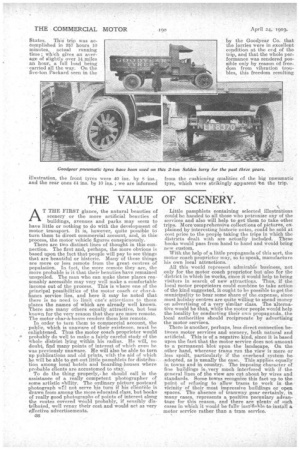PNEUMATIC TYRES FOR - HEAVY LORRIES.
Page 13

Page 14

If you've noticed an error in this article please click here to report it so we can fix it.
The Part They Play in the Reduction of Road and Vehicle Vibration.
T• HE ILLUSTRATIONS on the next page depict a 2-ton Seiden lorry, which has been running about the London district during the last three years. It is fitted with large pneumatic tyres and is in the service of the established tyre manufacturers, the Goodyear Tyre and Rubber Co. On the front wheels the tyres are 36 ins. by 6 ins., and on the rear they are 3a ins. by 7 ins. ; with one exception all the tyres shown are the ones angina uy fitted to this vehicle, the front wheels being shod in May, 1916, and the rear wheels the following month. The original nearside rear tyre burst a few weeks ago and had to be replaced; this misfortune was traced to under-inflation. As is only to be expected, the three original tyres show signs of considerable wear ; taking into account, however, the long period during which they have beenrunning, their condition may reasonably be described as excellent ; so much BO, that the Goodyear people are willing to exhibit the vehicle to interested inquirers.
After examining the tyres on the Selden lorry, we discussed with a Goodyear representative the ques. tion of applying large pneumatic tyres to commercial vehicle work generally. It is fairly well known that experiments 4bn a large scale have been in progress for some time in the United States, hut it is probably not generally realized in this country that these experiments-have been to a great extent successful, so far as demonstrating the suitability of the largesize pneumatic tyre is concerned. It is only natural that a tyre manufacturer should be unwilling to regard the solid tyre as representing the last word for commercial vehicles. The history of the tyre business is the history of the gradual evolution of the pneumatic tyre—in fact, it is not too much to say that the present-day stage of automobile development has been rendered possible of attainment only through the advent of pneumatic tyres as we now
know them. . Numerous claims have been put forward by the advocates of the substitution of pneumatic for selid tyres in commercial vehicles. In the first place, the cushion effect due to the greater resiliency of the former should mitigate the possibilities of evil accruing to the chassis from road shocks ; through this means, the repair bill ought to be diminished and the annual charge to the depreciation account substantially reduced. Breakages in the load itself ought also to be eliminated, and the greater speed that vehicles ought reasonably to attain, when they are running 011 pneumatic tyres, should increase the radius of action of each lorry. The latter item is important, as it might often make all the difference between returning from a country delivery on the same day, on the one hand, and having to garage in a strange town during the night., on the other.
All of this gives rise to the question—are reliable pneumatic tyres at present manufactured in large enough sues to permit of their being used on heavy lorries? It is claimed by Messrs. Goodyear that the cord construction adopted by them, in conjunction with the straight-sided design of tyre, has resulted in the evolution of what is a successful commercial proposition. Such tyres are selling plentifully in the United States at the present time, in sizes up to 9 Ms. That straight-sided tyres (held in position by suitable retaining rings) are used probably explains why manufacturers in this country have not taken up the question; beaded tyres of the conventional British type would be inadmissible in such large sizes, by reason of the tremendous difficulty that would be presented in putting them on and taking them off.
Our illustration below depicts a fleet of 5-ton vehicles which, last year, made a successful trip from Boston to San Francisco,. that is to say, from the Atlantic to the Pacific Coast of the United
States. TlLi trip was ac Complislied in 257 hours 10 minutes, . actual running time ; which giVes an average of slightly over 14 miles an hour, a full load being -carried all the way. On the • five:ton Packard seen in the
illustration, the front tyres were 40 ins. by 8 ins., and the rear ones 94 ins. by 10 ins. ; we are informed
by the Goodyear Co. that the lorries were in excellent condition at the end of the trip, and that the whole performance was rendered possible only by reason of freedom from vibration troubles, this freedom resulting from the cushioning qualities of the big pneumatic tyre, which were strikingly apparent tin the trip;






















